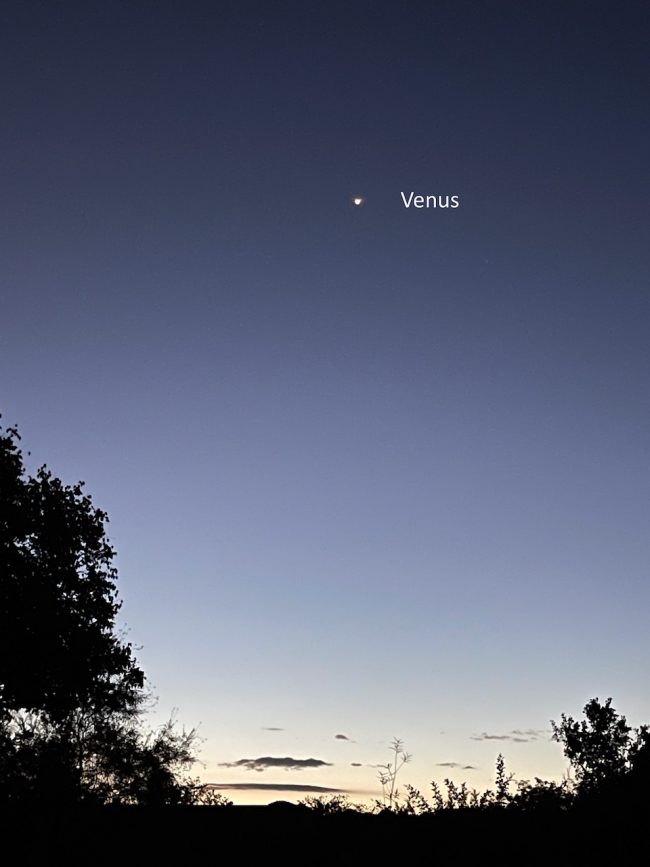
Greatest brilliancy for Venus is a treat! Watch for Venus in the east before sunrise around mid-September 2023.
Venus brightest in morning sky, around September 19
Venus is the brightest planet. It outshines any other object in our sky, with the exception of the sun and moon. And it’s dazzling around September 19, brightest for 2023. You can’t miss Venus! Look for it in the sunrise direction on any clear morning around now. When it’s this bright, Venus appears as an eerily eye-catching beacon in the morning sky. It’s visible not just in a dark sky, but in bright morning twilight as well.
Astronomers call the September 19 event a greatest brilliancy of Venus.
Venus will reach its peak in brilliancy – at magnitude -4.8 – on September 19. It won’t appear this bright to us again until February 2025, when it’ll reside in the west after sunset.
Venus before sunrise in 2023
Venus was in our evening sky when 2023 began. It left the evening sky – passing more or less between us and the sun – on August 13. Astronomers called the August 13 event an inferior conjunction of Venus.
But, by late August, Venus had emerged from the twilight glare at dawn. As seen from the Northern Hemisphere in early September, it made a beeline to a point high above the sunrise. Southern Hemisphere viewers can see Venus blazing in their eastern dawn skies now, too. From there, Venus isn’t as high in the sky before sunrise. It’s more to one side of the sunrise.
All this time Earth and Venus are moving in their orbits around the sun. Venus moves faster. And its orbit is smaller. Since its August 13 inferior conjunction, Venus has been fleeing ahead of Earth in its orbit.
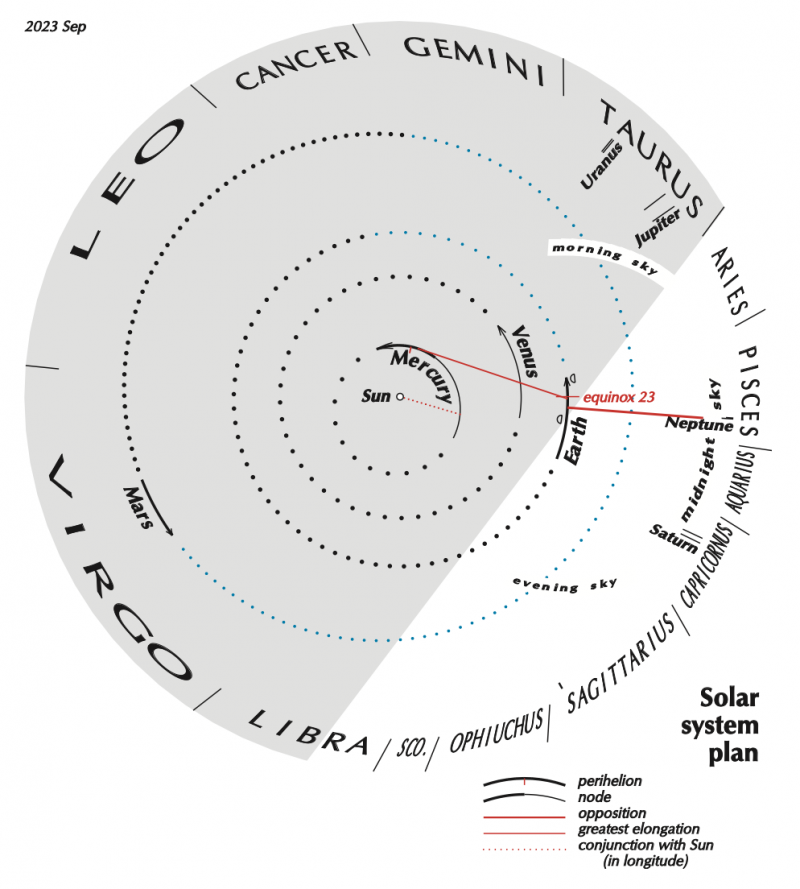
What is greatest brilliancy?
Greatest brilliancy for Venus is a combination of two factors: illumination and disk size. Remember … Venus passed us in its smaller, faster orbit on August 13. It was hard to catch that day (even in photos), because its lighted face was turned mostly away from us.
Even now, we’re still not seeing a fully illuminated Venus. Instead, as seen through telescopes – as Venus flees ahead – its phase has been increasing, like a tiny waxing moon. But, meanwhile, again as seen through telescopes, the disk size of Venus has been decreasing as the planet races ahead.
Illumination. Venus reaches its greatest illuminated extent on September 19. That’s when the lighted portion of the planet – the crescent Venus, seen through telescopes now – will cover its greatest area on our sky’s dome. Does this mean the phase will stop increasing now? No. It means Venus is at a maximum phase (25%) for its disk size.
Disk size. Remember, again as seen through a telescope, the disk of Venus is shrinking. In September, 2023, Venus goes from a 49-arcsecond crescent disk through telescopes to a 32-arcsecond crescent disk.
So greatest brilliancy for Venus is combination of maximum phase and disk size. The two combine to give us a bright planet Venus.
Then, as it flees ahead of us, the phase continues to increase … but the disk size decreases. So Venus will appear a smidgeon fainter to us a month from now, and fainter still (but still very bright!) by the year’s end.
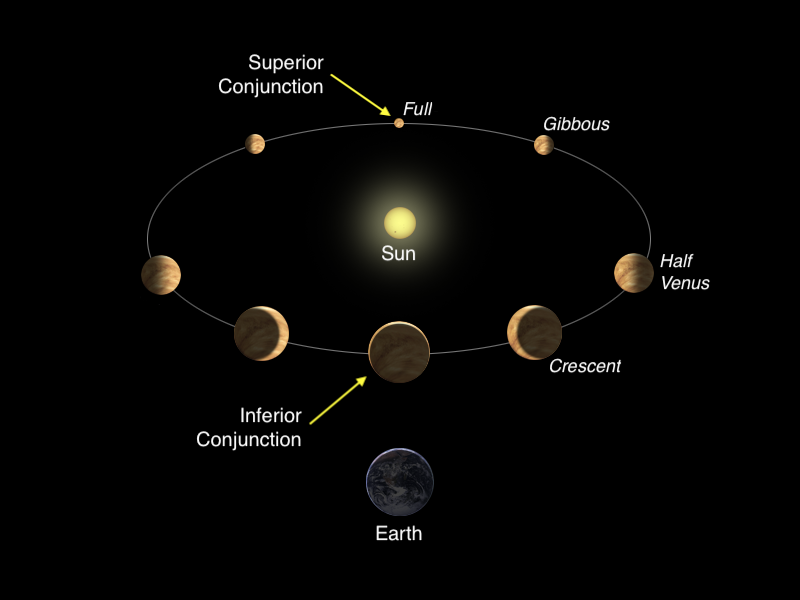
When greatest brilliancy happens
Venus’ greatest illuminated extent – or greatest brilliancy – in our morning sky always happens about a month before Venus reaches greatest western (morning) elongation. Its next greatest western (morning) elongation will fall on October 23, 2023.
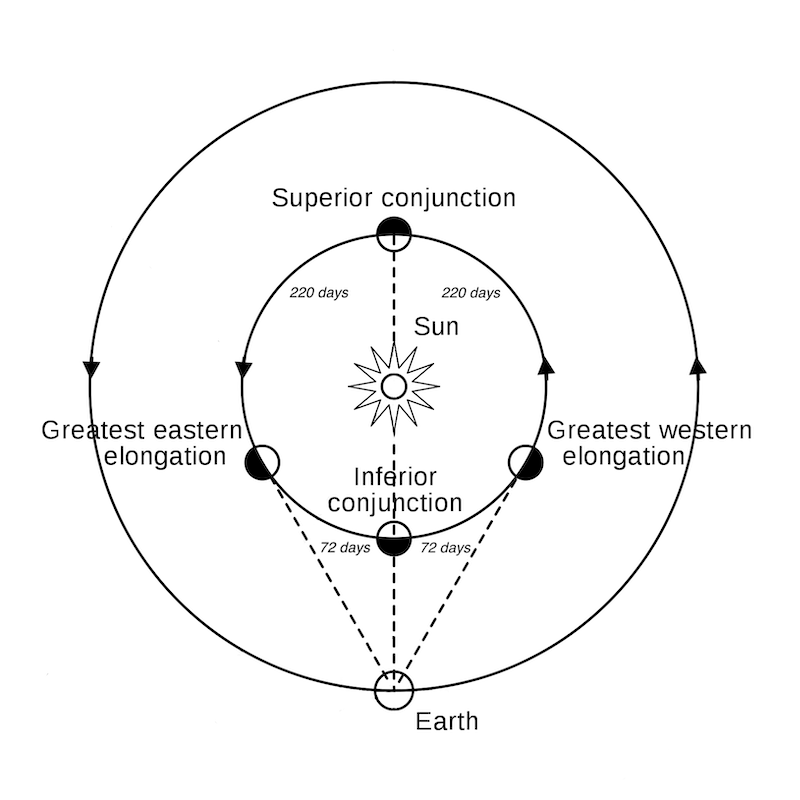
Venus charts for 2023, from Guy Ottewell
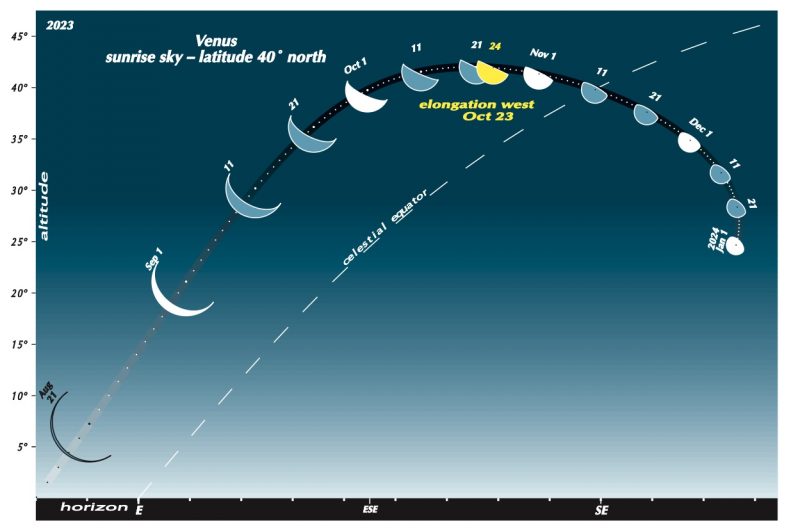
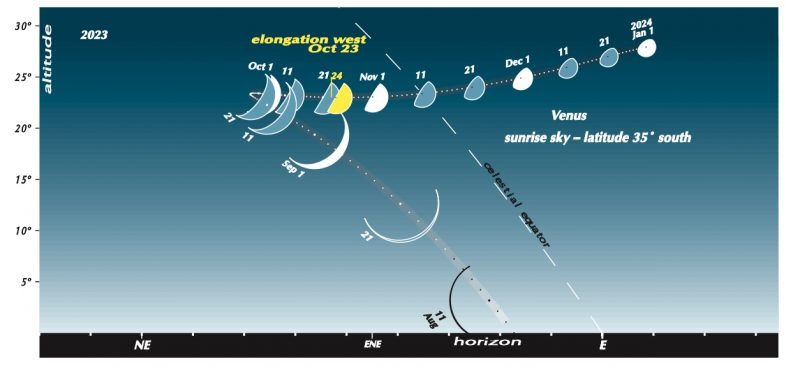
Venus photos from our community
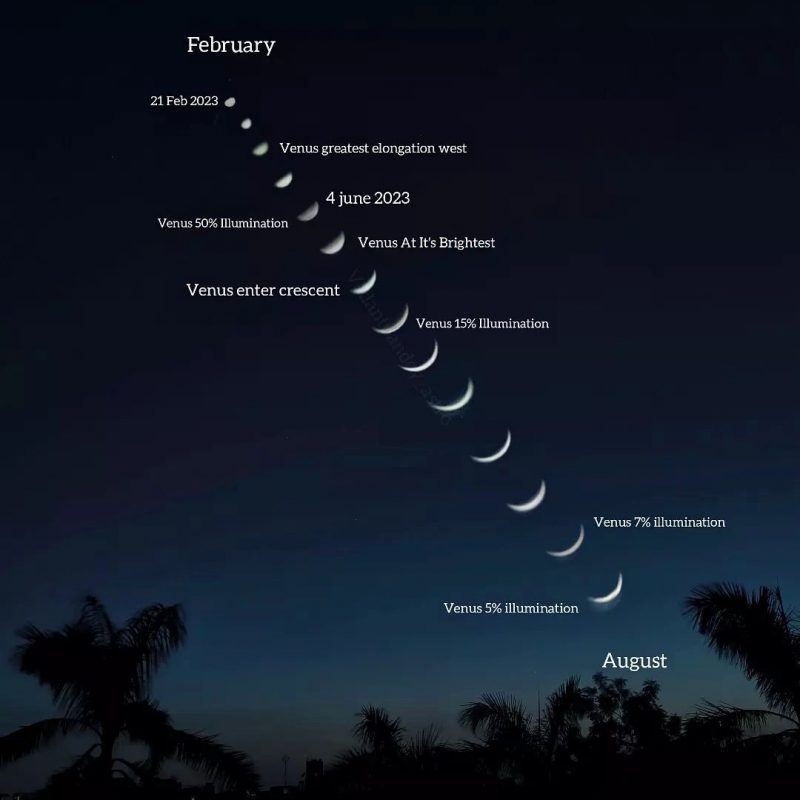
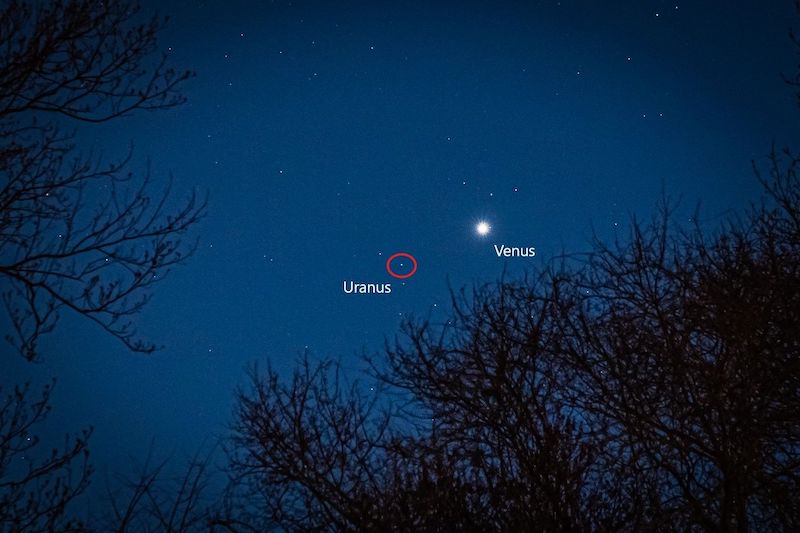
More Venus images
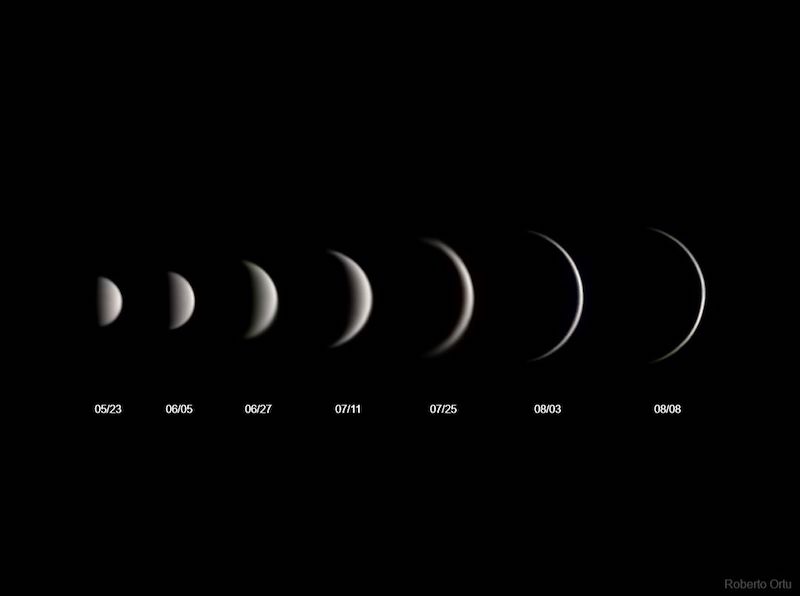

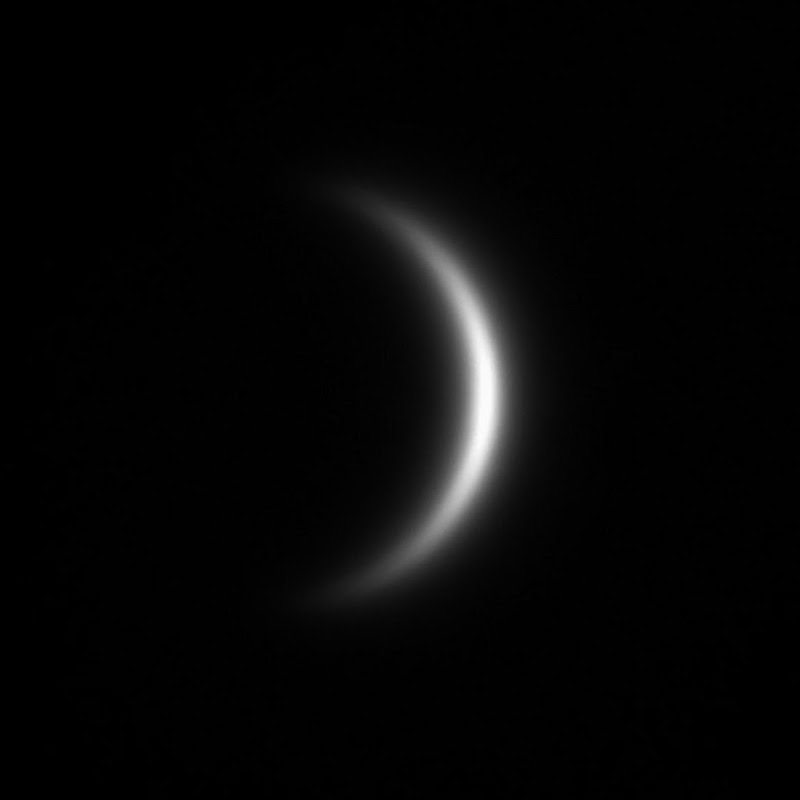
What’s next for Venus?
Though it’s brightest in September, 2023, Venus will be farthest from the sunrise – at greatest morning elongation – in October, 2023.
And it’ll continue to blaze in our morning sky – east before dawn – through March, 2024.
Bottom line: Venus will be brightest in the morning sky around September 19, 2023. After that, Venus won’t be this bright again until February and April of 2025.
Planet-observing is easy: Top tips here
EarthSky’s monthly planet guide: Visible planets and more
The post Venus brightest in morning sky September 19, 2023 first appeared on EarthSky.
from EarthSky https://ift.tt/O5wok0J

Greatest brilliancy for Venus is a treat! Watch for Venus in the east before sunrise around mid-September 2023.
Venus brightest in morning sky, around September 19
Venus is the brightest planet. It outshines any other object in our sky, with the exception of the sun and moon. And it’s dazzling around September 19, brightest for 2023. You can’t miss Venus! Look for it in the sunrise direction on any clear morning around now. When it’s this bright, Venus appears as an eerily eye-catching beacon in the morning sky. It’s visible not just in a dark sky, but in bright morning twilight as well.
Astronomers call the September 19 event a greatest brilliancy of Venus.
Venus will reach its peak in brilliancy – at magnitude -4.8 – on September 19. It won’t appear this bright to us again until February 2025, when it’ll reside in the west after sunset.
Venus before sunrise in 2023
Venus was in our evening sky when 2023 began. It left the evening sky – passing more or less between us and the sun – on August 13. Astronomers called the August 13 event an inferior conjunction of Venus.
But, by late August, Venus had emerged from the twilight glare at dawn. As seen from the Northern Hemisphere in early September, it made a beeline to a point high above the sunrise. Southern Hemisphere viewers can see Venus blazing in their eastern dawn skies now, too. From there, Venus isn’t as high in the sky before sunrise. It’s more to one side of the sunrise.
All this time Earth and Venus are moving in their orbits around the sun. Venus moves faster. And its orbit is smaller. Since its August 13 inferior conjunction, Venus has been fleeing ahead of Earth in its orbit.

What is greatest brilliancy?
Greatest brilliancy for Venus is a combination of two factors: illumination and disk size. Remember … Venus passed us in its smaller, faster orbit on August 13. It was hard to catch that day (even in photos), because its lighted face was turned mostly away from us.
Even now, we’re still not seeing a fully illuminated Venus. Instead, as seen through telescopes – as Venus flees ahead – its phase has been increasing, like a tiny waxing moon. But, meanwhile, again as seen through telescopes, the disk size of Venus has been decreasing as the planet races ahead.
Illumination. Venus reaches its greatest illuminated extent on September 19. That’s when the lighted portion of the planet – the crescent Venus, seen through telescopes now – will cover its greatest area on our sky’s dome. Does this mean the phase will stop increasing now? No. It means Venus is at a maximum phase (25%) for its disk size.
Disk size. Remember, again as seen through a telescope, the disk of Venus is shrinking. In September, 2023, Venus goes from a 49-arcsecond crescent disk through telescopes to a 32-arcsecond crescent disk.
So greatest brilliancy for Venus is combination of maximum phase and disk size. The two combine to give us a bright planet Venus.
Then, as it flees ahead of us, the phase continues to increase … but the disk size decreases. So Venus will appear a smidgeon fainter to us a month from now, and fainter still (but still very bright!) by the year’s end.

When greatest brilliancy happens
Venus’ greatest illuminated extent – or greatest brilliancy – in our morning sky always happens about a month before Venus reaches greatest western (morning) elongation. Its next greatest western (morning) elongation will fall on October 23, 2023.

Venus charts for 2023, from Guy Ottewell


Venus photos from our community


More Venus images



What’s next for Venus?
Though it’s brightest in September, 2023, Venus will be farthest from the sunrise – at greatest morning elongation – in October, 2023.
And it’ll continue to blaze in our morning sky – east before dawn – through March, 2024.
Bottom line: Venus will be brightest in the morning sky around September 19, 2023. After that, Venus won’t be this bright again until February and April of 2025.
Planet-observing is easy: Top tips here
EarthSky’s monthly planet guide: Visible planets and more
The post Venus brightest in morning sky September 19, 2023 first appeared on EarthSky.
from EarthSky https://ift.tt/O5wok0J

Aucun commentaire:
Enregistrer un commentaire